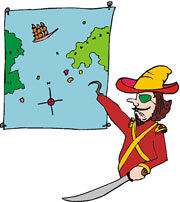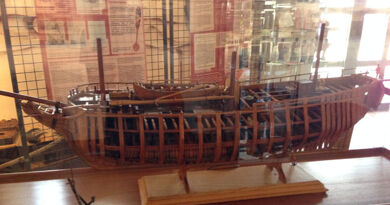Pirate Corsairs and Pirates
The history of the West Indies abounds in stories (of corsairs, pirates, buccaneers and buccaneers, which the imagination has amalgamated and whose mythical images have formed until reaching us crowned with prestige. But, who were they in reality, why such a boom in our region? Who were the most prominent members of the profession whose common goal was to plow or ravage the Caribbean Sea, the Gulf of Mexico, the Atlantic Ocean for the Gold, glory or adventure? If one believes Philippe Gosse in his History of Piracy, even if there are differences between Corsairs, Pirates and Boucaniers, it is not the easiest to determine for some .
The pirate is defined by Webster as “a thief on the high seas; the one who by open violence seizes at sea the goods of another person, especially the one who makes trade of cruising to steal or plunder. A skimmer of the seas. He appropriates in general, ships of all nations in all waters …, “
According to various researchers, piracy appeared very early in history; it is thus admitted that it began with the development of trade between the different states. The first exploits of the pirates of Antiquity go back, it seems, to the plundering of the cargoes of spices and silk coming from India by the tribes of the Red Sea. During the following centuries, particularly in the 16th, 17th and 18th centuries, piracy raged in Central America and the Caribbean.
In fact, two reasons, of a historical-economic nature on the one hand, and geographic on the other, contribute to its development:
1 °) The discovery and colonization by the Spaniards of regions rich in gold, silver, and precious stones. Because their only concern was to make the most of it and to repatriate as much wealth as possible to fleets of galleons. For example, with the exploitation of the Potosi mines of Crand Peru around 1545 (Bolivia does not yet exist as a state), the annual production of the mines in Spanish America reaches around 267,000 kilos of silver and 5,400 kilos of gold (Europe produces only 60,000 kilos of gold per year and at the same time). The Spaniards are then forced to increase their convoys of galleons difficult to maneuver on the high seas, and undergoing, from their dispersion in the Caribbean Sea, fires from all sides of pirates.
2 °) The geographical environment of these regions which offer a profusion of islands of little interest for Spain, but, oh how many, coveted by the other European nations also eager, to have their share of the cake. These islands have, in fact, “coves, beaches, peaks, rocks, reefs, in short all the facilities to watch, surprise, attack”, the rich “flotas” on their way back.
Unlike the Pirates who operate at any time, the Corsairs appear particularly in time of war: “(…) They race which becomes a weapon of war among others”, that is to say – to say that they arm, ships with the more or less explicit authorization of a government to fight the naval trade of an enemy state. It is worth remembering that in the 16th and 17th centuries, the excitement of the lust of other European nations against Spanish and Portuguese possessions was at its height. These states (France, England, later Holland) never accepted the Alexander VI bubble well, sharing the world between the two Iberian powers.
Between 1523 and 1600, the French corsairs: Jean Ango (1523), Jean Le Clerc (1553); the English privateers: John Hawkins (1565) and especially Francis Drake (1568 -1577) multiply the exploits to weaken the Spanish and Portuguese fleets, to control the maritime routes and especially to cancel “the line of march”. The lively challenge of the latter made retort by Elisabeth 1st to the Ambassador of Spain, who came to complain about the misdeeds of Francis Drake, this sentence become famous “The use of the sea and the air is common to all. And no title whatsoever to the ocean can belong to any people, or to any individual, given that their nature, or the condition of public use, does not allow any possession of the air or the sea … “
Clark Russel in “The Life of William Dampierre” (pirate or English privateer), portrays them “(…) as a community of wild, shaggy, fierce and dirty men.” They were mainly French settlers, whose number had been increased from time to time by large contributions from the bottomlands of more than one European city or town … These people were dressed in a shirt and coarse linen pants that they soaked in the blood of the animals they killed. They wore a round cap, (pigskin hoods rising along the leg, and an untanned skin belt, in which they stuffed their sabers and their knives. They also armed themselves with muskets … The places where they dried and salted the meat were called “boucans.” It was from this expression that the name “boucaniers” came. They hunted and slaughtered the horned beasts and trafficked with their flesh, their favorite food was the raw marrow of the bones of the beasts they had just killed. They took their meals and slept on the floor, their table was a stone, their bolster the trunk of a tree and their roof … the warm and sparkling sky of the Antilles … ” The buccaneers flourished especially in the middle of the 17th century; after their ousting of Hispaniola by the Spanish, they settled in a small island off the northwest coast: The Island of the Turtle … They built a fort there and installed a sort of republic until their annexation by France which appointed a governor there; a mixed community of planters and buccaneers was established.
The island of Tortoise acquired a fame which attracted all kinds of adventurers without faith, or law, wanting to make a fortune quickly, to the detriment of a single enemy: the Spanish … Tortuga soon became the warehouse for the boucan and skins from Hispaniola, as well as the booty taken from the Spanish and which was traded for brandy, cannons, powder and cloth from French or Dutch ships who were relaxing there … “
In 1678, a book was published “Histoire des Aventuriers filibustiers qui s’entonces dans les Indes”, a sort of logbook written by Oexmelin, a barber surgeon, living among these adventurers. He described there the most remarkable aggressions committed, against the coast of the Antilles, by the buccaneers of Jamaica and the Turtle both English and French, and especially their way of life, their organization, and the rules which they observed. Indeed attacking a Spanish galleon especially in the manner of the French buccaneer Pierre Legrand, (in 1665, the latter had accomplished the feat, by means of his small boat moved to rowing with a sail, to seize a a very rich Spanish galleon), was not an easy task.
Oexmelin gives us an idea in his work “First fruits of an expedition”. “(…) They team up 15 or 20 together, all well armed with a 4 foot cannon rifle, firing a sixteen pounder to the pound, and usually a pistol or two at the waist. With that, they have a good saber or cutlass. The company being formed, they choose one of them for chief and embark on a canoe which is a small nacelle of a single piece, made of the tree trunk which they buy together, unless that which is the chief does not buy it alone provided that the first building they take will be his own ”.
Then they take care of the food supply: “(…) When there are 30 or 40, depending on the number they have concerted and the size of their boat, they think of refueling it, and they do so without spending any money. For this, they go to certain places to spy on the Spanish who have corals or parks full of pigs, they force those they can surprise to bring them 20 or 300 fat pigs according to what they need … while some salt these pigs, others collect wood and water for the trip …) “. And they determine the obligations that everyone is required to observe: (…) they make an agreement which they name between them hunting party to regulate what must return to the captain, the surgeon, the cripples, each one according to the magnitude of its evil. The crew chooses 5 or 6 of the main members with the chief or captain, to make this agreement which contains several articles ”. These articles specify in detail, the amount of money that each person will receive for the trip, the source of the payments being the overall result produced by the whole expedition, because moreover, they obey the same law as all other pirates: no loot, no pay … “. The distribution of the spoils was made precisely: – the captain received a separate payment for his ship. as well as the carpenter who was repairing. and the surgeon. – the part taken by the provisions was removed from the common fund. After deduction of these sums an equal distribution was made between the members of the team taking all the same into account a few situations: that of the captain, the expedition leader and the second who were allocated 5 or 6 times the share of a simple sailor: the diversion of anything for his benefit put the individual in condition of being expelled without delay.
On the other hand, they had instituted a kind of social security whose code charged for the loss of different members of vital organs. loss of the right arm: 200 ECU or 2 slaves loss of a foot or a leg: 200 ECU or 2 slaves loss of a Grill: ECU 100 or 1 slave loss of 2 eyes: ECU 600 or 6 slaves loss of a finger or an ear: ECU 100 or 1 slave



